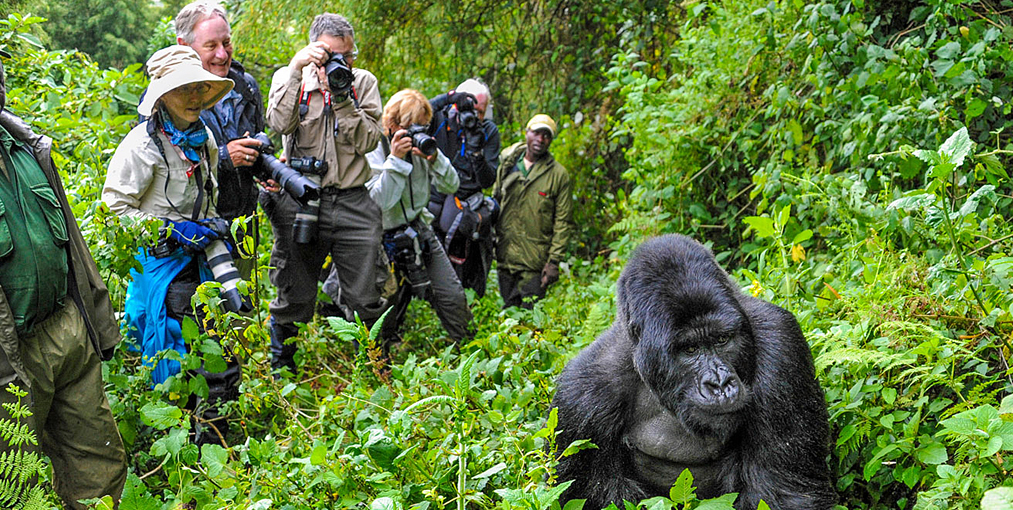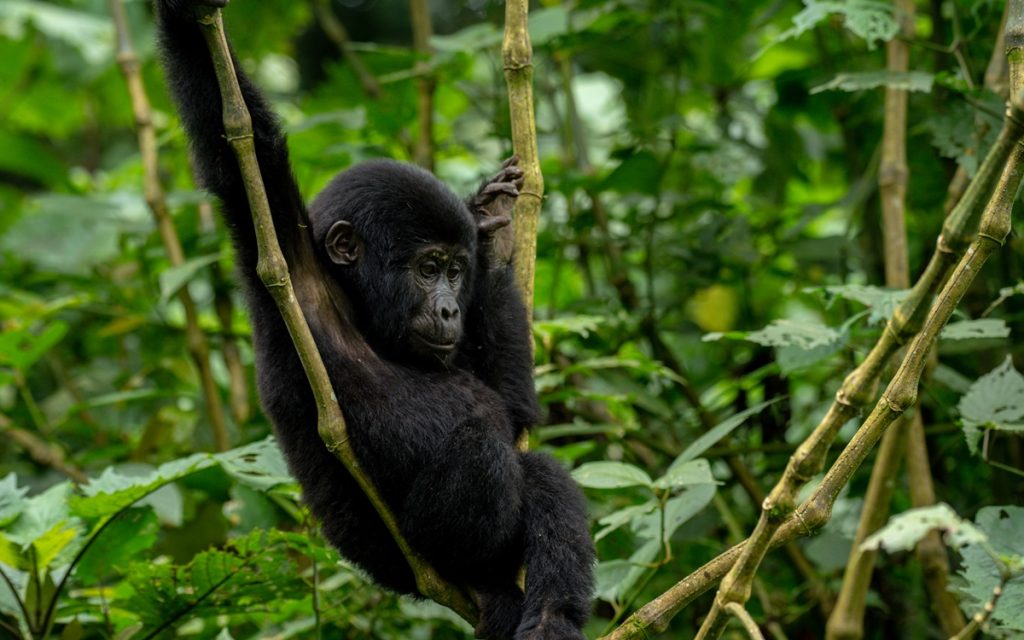- Written by: Friendly Gorillas Editor
- December 20, 2024
Chimpanzee vs Gorilla
Chimpanzee vs Gorilla
For primate safari and adventure lovers, an African safari that does not include Chimpanzees or gorillas is considered incomplete.
Native to Africa, both gorillas and chimpanzees share a range of similarities, from their social behaviours, diet and more.
Both chimpanzees and gorillas have been seen displaying immense level of intelligence such as use of tools like sticks to measure water depth, sticks to pluck ants, solving disputes within the members and parenting among others.
However, their differences in physical characteristics, habitats, and behaviour make them uniquely intriguing. Understanding these differences can help you appreciate the distinct roles they play in their ecosystems.
Throughout the year, people travel from all over the world to witness how these gentle giants play, feed, relate and mate.
With a well organized safari, you can witness these apes mate, feed and play with their young ones.

Social structure.
Chimpanzees live in large, dynamic groups called communities, which can consist of up to 100 members while gorillas live in relatively smaller group of about 30 maximum.
The chimpanzee community is led by an alpha chimp while a gorilla troop is led by a dominant alpha silverback.
Behaviour.
Behaviourally, chimpanzees are known for their playfulness and use of tools, which are passed down through generations, reflecting their ability to learn and adapt. Gorillas are more reserved and spend much of their time foraging or resting.
Their social interactions are generally gentle, with minimal conflict within the group. These behavioural differences underscore the distinct lifestyles of these two primates.
Communication.
Chimpanzees are highly vocal, using a range of sounds, facial expressions, and gestures to convey emotions and intentions. They are capable of complex social interactions, which are critical for maintaining their dynamic group structures.
Gorillas communicate primarily through gestures, chest beats, and low grunts.
The silverback’s chest beat is particularly notable, signalling dominance or warning to potential threats. These communication methods reflect the social and environmental demands placed on each species

Similarities
Chimpanzees and gorillas, two of Africa’s most iconic primates, share many similarities due to their close evolutionary relationship. Both species belong to the Great Ape family, which also includes orangutans and humans.
Physical Features
Chimpanzees and gorillas are both large primates with strong, muscular builds adapted to their forest environments.
They share opposable thumbs and toes, allowing them to grasp and manipulate objects. Their forward-facing eyes provide depth perception, which is crucial for navigating complex forest landscapes.
Additionally, both species have a similar dental structure suited for their omnivorous diets, including sharp canines for defense and molars for grinding plant material.
Social structure
Chimpanzees and gorillas both exhibit strong social bonds and cooperative behaviors.
Grooming is a shared activity in both primates, serving to strengthen relationships and maintain group cohesion.
Suggested Safari Itineraries
Tool Use and Problem-Solving
Both primates are known for their intelligence and ability to use tools. Chimpanzees frequently use sticks to extract termites or stones to crack nuts.
While gorillas use sticks to gauge water depth or as support when crossing swampy areas. These behaviours demonstrate their problem-solving skills and adaptability.
Lifespan and Reproduction
Chimpanzees and gorillas have similar lifespans, typically living 35-50 years in the wild. Females of both primates give birth to a single offspring after a gestation period of about 8-9 months.
The infants are highly dependent on their mothers for care and protection, and both primates demonstrate extended parental investment, which is critical for the survival of their young.
Intelligence
Chimpanzees and gorillas exhibit advanced cognitive abilities, including memory, problem-solving, and self-awareness. Both primates can recognize themselves in mirrors, a trait linked to higher intelligence.
Both chimps or gorillas are capable of learning new behaviours and when trained, both gorillas and chimpanzees can solve basic maths challenges.
In captivity, both gorillas and chimpanzees have been found to use sign language to communicate with humans after training.

Recommended Safaris
Communication
Both chimpanzees and gorillas have been seen to display a wide range of emotions, including joy, anger, exhibiting sympathy to distressed member and sadness.
These communication methods highlight their advanced cognitive abilities and social intelligence.
Ecological roles
Both chimpanzees and gorillas play vital roles in the natural ecosystem’s lifecycle. Chimpanzees contribute to seed dispersal, aiding forest regeneration.
Gorillas, as mega-herbivores, help shape vegetation structure and contribute to the overall health of their habitats. Their presence indicates the well-being of their ecosystems, making their conservation critical.
Unique Primate Species in Pristine Habitats
Uganda is one of the few countries in the world where you can see both mountain gorillas and chimpanzees in the wild. With more than half of the total population of mountain gorillas in the world,Bwindi Impenetrable National Park and Mgahinga Gorilla National Park provide the rare chance to encounter mountain gorillas at a relatively fare price compared to Rwanda..
Meanwhile, Kibale National Park, often called the “Primate Capital of the world” is a major place to encounter chimpanzees in their natural habitats.

Where to see Chimpanzees and Gorillas in the wild
Chimpanzees and gorillas are native to Africa. Chimpanzees are primarily found in the tropical forests and savannah and woodlands of Africa whereas gorillas’ habitat in dense rainy forest and mountainous areas.
In Africa, popular destinations for these primates include Uganda, Rwanda, Democratic republic of Congo and Gabon.
Friendly Gorillas arranges unforgettable gorilla and chimpanzee trekking safaris to the Africa’s most exciting primate destinations in Uganda and Rwanda.
In Uganda, you will go chimp trekking in Kibale National Park, a prime chimpanzee trekking destination located southwest of Uganda, Budongo Forest Reserve in Murchison Falls National Park, also a renown primate sanctuary found south of Murchison Falls National Park, Kyambura Gorge in Queen Elizabeth – a third most popular place to see chimpanzees in Uganda, with a high sighting probability.
Other known destinations for encountering chimpanzees in the wild in Uganda include Kalinzu – with over 300 chimpanzee individuals, Semuliki Wildlife Reserve situated just In the western corner of Uganda.
Where to see Gorillas in the Wild
Gorillas are only found in the sub-montane forests in Africa. The Wester subspecies are found in Nigeria’s Nile Cross National park and in Central African Republic while the Easter lowland gorillas may be visited only in Congo’s Kahuzi Biega National Park. The most exciting one, the eastern mountain gorillas can only be found in the Virunga range of mountains shared by Uganda, Rwanda and Democratic Republic of Congo.
In Uganda, gorilla trekking is only done in Bwindi Impenetrable and Mgahinga gorilla national parks while, Rwanda’s gorillas may be visited in the famed Volcanoes National Park. Lastly, Congo’s mountain gorillas can be visited by a well arranged gorilla trek in Virunga National park.
Due too insecurity in the Democratic Republic of Congo, Virunga’s gorillas are currently inaccessible by tourist. Your best bets are Uganda and Rwanda.
Conclusion
Without a doubt, Chimpanzees and gorillas have various similarities. From the impressive intelligence, abilities to communicate, use tools to solve daily challenges and exhibiting immense social intelligence such as expression of emotions, celebration of newborns and more.
The similarities are best experienced than told. Your well organized chimpanzee or Gorilla trekking adventure is just a step away by sending your inquiry.
Friendly Gorillas Editor

Ready for your ultimate wildlife experience?
Chat with us, our team is always here to help!
You may also like …

Got any questions
about traveling to Uganda?
Get in touch.








